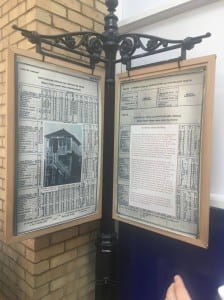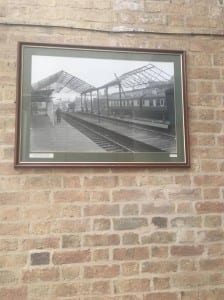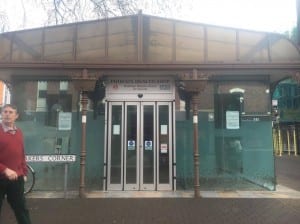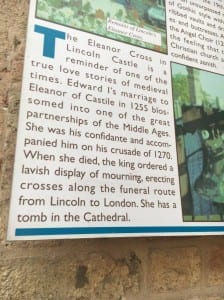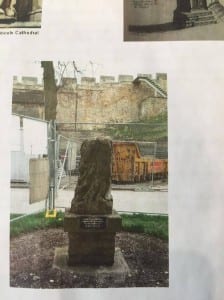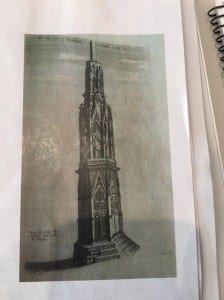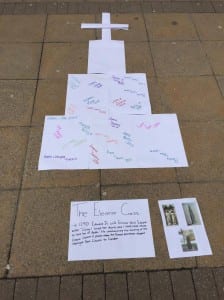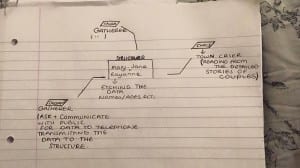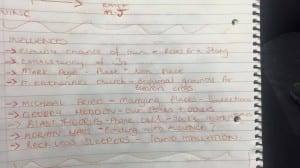Framing Statement
We have created an installation piece (Not performative) based around the audiences romance life’s. We’ll be discussing with the audience about their relationships, and how certain areas in Lincoln may bring back certain memories relating to their relationship. We have concentrated on involving visual art such as, and originally thought of ideas such as a washing line with images of the couples hanging, posted notes describing how certain areas of Lincoln remind them of their partner, creating paintings to express how they feel about their partner and a placard advertising our aims towards the audience. Eventually we came up with the idea of creating a wooden box, influenced from the Elinor Cross. Our aim is to carve the couples initials we gathered onto the box, and shout out different locations and relationship information we have gathered over the performance process. The site we chose was in the middle of the high street, simply because it’s constantly busy and we wanted to interact with as many people as possible. We have many research influences that have inspired us to create this performance. Some of the main inspirations for our performance would be Duncan Speakman. His aim is to work out the narrative of an experience and the politics of public space. He also concentrated on sound and mobile technology, wrapping them all up in melancholy and romance. Duncan Speakmans work allows the city to be mobile (expressed) by those that walk, sit, and move around within the city. The text is made mobile (Read/Expressive) by the reader. The cloths that are worn within Speakmans performances are productive to the meaning of the performance. Another important influence for our performance would be from Bob Wolly and Lea Millers site specific piece Partly cloudy, chance of rain. This piece relates to our idea of having swapping roses for a love story, from a member of the public on the high street. We explored the city centre, paying particular detailed attention to our surroundings in Lincoln city centre, to give us a clear idea of what our performance will be based on. Throughout some of the weeks leading to week seven, we took art in practical activities to help is explore Lincoln city centre in more depth and give us a clear sense of some of the history of the building and certain areas. One example would be the list of instructions task, where each group followed a list of instructions to follow based in the city centre.
Analysis of process
In the first Site Specific session, we discussed different ideas for the performance relating to research we’d undertaken of Lincoln . Some people mentioned the history within Lincoln city, dating back to the Roman ages. Some drew an interest too ghost story’s and murder cases. We discussed how this research could be transformed into an appealing piece of site specific performance. One particular idea I remember is a tour of Lincoln, involving taking people on a journey across the city and discussing the history, facts and story’s that had gone on in certain areas of the city. We we’re placed into separate groups of three, given the task to write clear instructions for another group to follow and explore the city. These instructions we based on Carl Livery’s 25 instructions, aiming to make the reader get out and explore a site. Once we we’re given our tasks, we headed out into the city to follow our instructions. The first instruction was to walk all the way up to the top of the high street, then place our hand on the left side of the street following the wall for 10 minutes. Once we stopped, we had to draw the first thing in front of us. This happened to be a large pile of junk, consisting of a broken table, metal poles, rotten wood, metal containers and a large empty tin of vegetable oil. The final task was to walk back to the University, completely avoiding the high street. We found this literally impossible, as we had to pass through the high street at some point to access a different route. Once we arrived back at University, everybody discussed there experiences out in the City. Luckily, we came up with the idea to create a snap chat of our adventure recording it on our phones.
The next session consisted of us discussing our experiences with the instructions challenge, explaining our journeys to the class. We moved on to watching a video of an experiment by John Smith. He’s recording the general public walking past in the street (E.G Women, Men and children), whilst telling them what to do. For instance if a women walked from the left side, with an umbrella in her hand, he would say “Now, I want the women with the umbrella in her hand to walk on from the left” (University of Lincoln, 2011). He persisted to do this with everyone that walk past in the sight of the camera. We also watched a video on Marcia Farquhar giving a tour of the history, Phyco-Geogrpahy, biography and autobiography in London. She discussed her performance and how she is very much in the movement. She says that the performances she “creates is never the same” and she’s “very much in the moment” (University of Lincoln, 2016). We also looked into Mike Pearsons article, as he discusses how Richard Sera thinks “to remove the work is to destroy the work”. Dr D. Headon followed Pearson’s work and she used scriptotherapy, where you wrote about experiences that have taken place in your own life (Mainly negative things). We also spoke about Mi Wong Quon, who wrote a book called One Place After Another, bringing things from visual art to performance. Finally, we ended the session discussing everyone’s ideas for the performance and forming groups based on similar ideas. I joined a group, with the idea of creating a performance based on peoples emotional experiences in Lincoln. We sat down, and began brainstorming different ideas on how we could create a performance.
Steve’s session began with a 4-5 minute video explaining “What is live art” by Joshua Sofaer, with him standing on a busy street in London. He describes live art in the sense that the actor “chooses to make work directly in front of the audience” (University of Lincoln, 2011). An interesting point he makes is that when a site specific performance is taking place “the city itself becomes a gallery” (University of Lincoln, 2011). Towards the end of the video, there is a comic aspect where he turns around and there’s a large hole in his trousers showing his bum. After the video, Steve sent each group out to explore the city center, for performance ideas. This was really helpful as we came across some interesting areas for the performance. We considered setting the performance near a building close to speaker’s corner because, situated in a busy section of the high street, giving us to opportunity to appeal to a wide range of audience members. Also we had a look at the old train station, which now is a cooking utilities store called Lakeland. The station became particularly interesting when we met an Old couple, explaining the history behind the station. Considering our performance is based around relationships, we used this opportunity to ask about their relationship (E.G, how they met, how long there we’re together). It was really interesting, because the station was a significant factor to there relationship when they were younger, as the man travelled on the train everyday to visit her in Newark.
Image One: This is one location we considered using for our performance.We considered having a washing line hung from lamppost, to the other.
Image Two: Images of the old train station, situated inside the Lakeland store.
Image Three: Here is an image of the building we’re considering to use for our performance. We were thinking about placing the washing line idea, hanging images and information of the couples around the pillars.
Image One:
Image Two:
Image Three:
On week 7 we had a group meeting in the library. Steve suggested that the sites we had chosen might not be totally suitable for our performance, because they didn’t have relevant history relating to our performance. Luckily we found information on “The Elanor cross” which completely related to our theme of love in Lincoln. We used this story, did some more in depth research and came up with some really interesting ideas to show Steve. We’ve decided to use the Elinor cross as an inspiration for our piece, as we’ll be creating our own version of the cross out of pieces of wood. We have managed to gather a large amount of images and information on different couples (E.G where they met, amount of time they’ve been together and one particular memory that reminds them of Lincoln as a couple), then used this information to place on our replica of the Elinor Cross. We’ve also came up with the idea of using a town crier effect, where one of the group members (preferably someone with a loud voice) shouts the relationships information on the couples we’ve gathered. In the session, we set out into the town centre to experiment with our ideas. We typed out the relationship information, for Chris to shout out in the middle of the high street. Rayanne and Mary Jane bought some paper, and created a version of the Elinor Cross and stuck it on floor on the high street. We’ve decided that I will be situated on the high street, asking couples about there relationship (How long they’ve been together, where they met, memories fond to them in Lincoln). I wrote the information I’d gathered, and handed it to Mary Jane and Rayanne for them to carve the names into the wooden Elinor cross. I also bought some plane rectangular cards, for me to write the information down and hand to Mary Jane and Rayanne. The information I gather will also be used for Chris to use, and shout it out in the street.
Once all of the information was gathered, we began making the overall performance more stable. We made large cards with the relationship information of each couple inside, and added a red love heart on the front. For the wooden box, Rayanne managed to gather four wooden pieces to make the box, and we hammered them together. Conan and Steve suggested that we’d paint the box a darker colour, as it would look more effective when it came to carving names onto the box. We each used a small carving tool to write initials of couples, patterns and love hearts to represent the couples love. We used a wooden pallet and attached 4 large wheels on the bottom to role the box around to our destinations. Finally, we attached a metal hook and a long piece of rope to the pallet, so we could drag the box around, making it easier for us to travel with the box. Rayanne also managed to get her hands on four individual smaller boxes for us too stand on, whilst reading from the sheets of paper. These boxes were covered in white sticky paper, and placed in a safe location ready for the performance date.
Image One: Image of information on the Elinor cross, explaining the history and the love story between Edward I’s and Elinor .
Image Two: This is what the Elinor cross looked like when it was first made.
Image Three: This is the Elinor Cross now.
Image Four: Our image of the Elinor cross created out of paper.
Image Five: Image of the basic structure of how we’ll be set out in Lincolns city center.
Image One:
Image Three: Image Two:
Image Four:
Image Five:
When it came to showing an example of our performance to Steve and other class members, Me, Chris and Mary Jane stood on the high street shouting out the relationship information we had gathered. We also explained our ideas, and showed them an example of the Elinor Cross we would be creating. At the end we was given constructive feedback. There seemed to be mixed views on the shouting in the street, with some people saying “it was intimidating” (Fossey, 2016) and others saying “it was really appealing, and would make the general public intrigued” (Fossey, 2016). We couldn’t completely show our performance, since it’s mainly a non-per formative piece anyway. After this feedback, my group and I went away and discussed this feedback, reflecting on the things we could improve for next session. Unfortunately we also found out that a member of the group would be leaving University. This effected us all a little, as we had to restructure the performance. Luckily our piece isn’t massively performance based, so it didn’t effect the actual piece drastically.
Image One: The list of site specific work that has inspired our performance.
Performance Evaluation:
I thought the performance went very well. There we’re plenty of positive aspects, and all the hard work and preparation defiantly paid off. I thought we all spoke with good clarity, diction and the projection was perfect from everybody. I thought the synchronization of the transactions of us changing positions to carve names on to the wooden box went extremely well. There we’re elements that I thought we’re a little sloppy, such as us holding the cards up at the wrong time or some people being slow at moving to stand on to the box. I myself made one particular mistake, where I didn’t read the destinations before I approached the box to carve. I think this effected the performance negatively, as everyone else remembered to read there destinations, so it looked a little unprofessional from my prospective. However, I do think I dealt with the situation in a positive manner, as I didn’t let it effect the rest of my role throughout the performance. Overall, I’m very happy with the progress we’ve made from week one to the performance. We’ve had many ups and downs, with disagreements on ideas due to people having different suggestions. Even with a member leaving the group at short notice, we haven’t let it effect us. I think teamwork and hard work was a huge factor in this performance, and I well and truly believe every member in this performance worked really hard to deliver their role effectively. If I was to do the performance again, I would learn how to carve more accurately onto the wooden box. Obviously with it being my first time, I wasn’t sure how to approach the carving, so it took me a while to get the hang of things. However, I’ve well and truly loved site specific performance, and it’s defiantly an experience I would thrive to do again.
Reference List:
University of Lincoln (2011) Visiting lecturer: John Smith – The Girl Chewing Gum 1976 Available from https://www.youtube.com/watch?v=57hJn-nkKSA [accessed 1 February 2016].
University of Lincoln (2012) Visiting lecturer: Marcia Farwuhar – A live art tour Available from https://www.youtube.com/watch?v=1Li90TEcsUw [accessed 6 February 2016].
University of Lincoln (2011) Visiting lecturer: What us Live Art? Available from https://www.youtube.com/watch?v=LOUxv4Do01g [accessed 15 February 2016].
Fossey, S. (2016) Site Specific performance feedback on performance [seminar]. DRA2035M, University of Lincoln.

